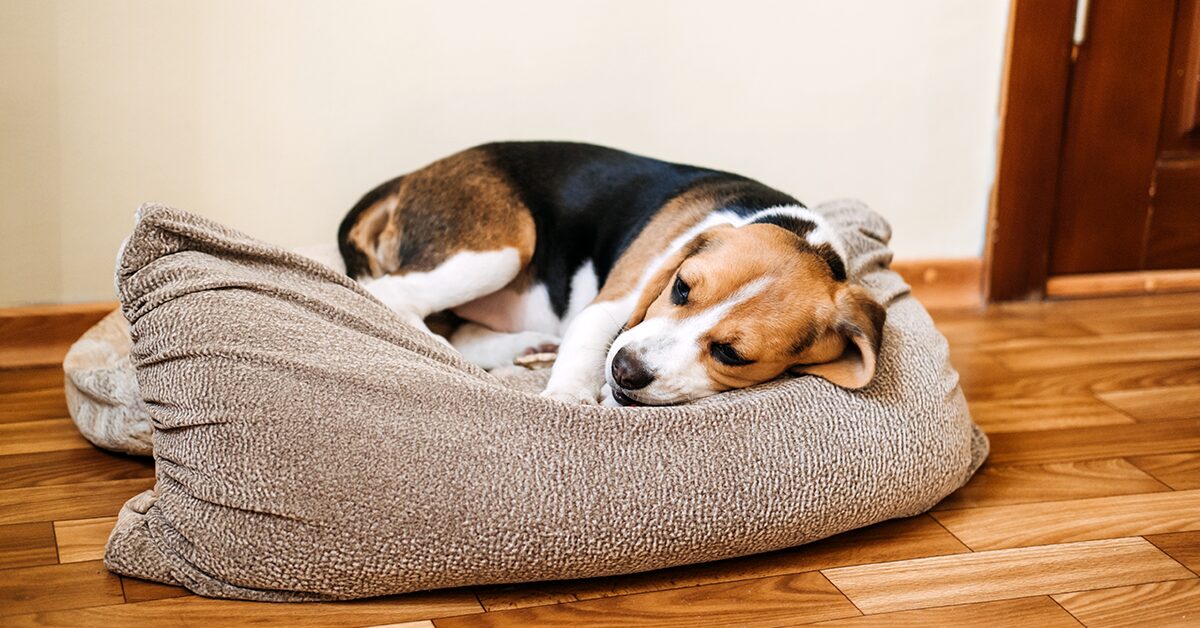Parvo, or Canine parvovirus (CPV), is a serious and sometimes fatal disease amongst dogs. However, it is also highly preventable, and its symptoms can be treated through supportive care.
A parvo diagnosis is a difficult one to receive, but the more you know, the more prepared you will be to take on the challenges of this virus. We’re covering parvo’s causes, symptoms, and the steps you can take to prevent its spread.
What is canine parvovirus?
Canine parvovirus (CPV), commonly referred to as parvo, is a viral disease that primarily affects the gastrointestinal tract. It can also sometimes affect the heart muscle, lymph nodes, and bone marrow. While dogs of any age can become infected with parvo, puppies are the most susceptible.
This virus spreads throughout an infected dog’s body, destroying healthy cells and causing a low white blood cell count. This leads to reduced immune function. Once the virus destroys protective cells, it penetrates the gut barrier and the small intestine’s protective walls, making proper absorption of nutrients difficult. Because parvo impairs a dog’s immune system, it can also sometimes lead to secondary bacterial infections.
What causes parvo?
Parvo is a common and highly contagious virus. It most commonly spreads when a healthy dog comes into direct contact with an infected dog. Dogs infected with the disease tend to have an especially high concentration of it in their stool. Any form of contact with an infected dog’s stool – even just sniffing – is likely to cause infection.
Unfortunately, parvo can also live on surfaces for up to a month or longer. This means that a dog can become infected just by coming into contact with a contaminated object, like a food or water bowl, collar, or a leash recently used by an infected dog.
Humans cannot become infected with parvo. However, humans who come into contact with infected dogs can spread the virus to healthy dogs via their hands or clothes.
Symptoms of parvo
The earliest clinical signs of parvo are often gastrointestinal. You may notice your dog experiencing:
- Diarrhea
- Bloody stool
- Severe Dehydration
- Lethargy
- Depression
Some dogs diagnosed with parvo also experience loss of appetite, weight loss, anorexia, and bacterial infections. For very young dogs, parvo may cause myocarditis, or inflammation of the heart.
How is parvo diagnosed?
Schedule a vet visit as soon as possible if you notice any of the common symptoms of parvovirus so your vet can conduct a thorough examination. Many symptoms of parvovirus are also symptoms of other diseases and could be serious in their own right.
Most likely, a vet will examine your dog’s abdomen and then perform an ELISA stool test. The vet will take a sample of your dog’s feces and test it for the virus.
How to treat parvo
Although there is no cure for parvo, a vet can provide supportive care by treating individual symptoms of the disease. Depending on the severity of your dog’s symptoms, a vet may:
- Prescribe medications to combat gastrointestinal issues like diarrhea and vomiting
- Administer electrolytes to combat dehydration
- Administer intravenous fluids to ensure your dog is getting adequate nutrition
- Perform blood transfusions
- Prescribe antibiotics for secondary infections caused by an impaired immune system
While parvo can be fatal, many dogs treated by a vet recover from their symptoms within a week. The survival rate for dogs treated by a vet for parvo is 68-92%.
Is my dog at risk for parvo?
Puppies birthed by a vaccinated dog are born with some antibodies. However, these begin to wear off around week six of life. This is why puppies between six and 16 weeks old are most susceptible to parvo. Puppies receive a series of vaccinations within this age range, and they do not reach full immunity until after the full series is complete.
Certain dog breeds are more susceptible to Parvo than others. These include Rottweilers, Labrador Retrievers, German Shepherds, Dobermans, and American Staffordshire Terriers.
How to prevent parvo
Get your dog vaccinated
The best way to prevent parvo is to follow your puppy’s vaccine schedule. The parvo vaccine is considered a core vaccine, meaning it’s highly recommended for all dogs.
Puppies between six to 16 weeks old should receive a series of at least three doses of the parvovirus vaccine. These doses should be given in intervals of three to four weeks. One year after this initial vaccine series, puppies should receive a booster. Then, dogs should receive another booster every 3 years.
With Pumpkin Preventive Essentials, you can receive a 100% refund for any 4 puppy vaccines at the vet in your puppy’s first year of life. This can include the life-saving parvo vaccine!
Stop the spread
Because parvo is highly contagious, pet owners need to ensure that infected dogs are quarantined. Some puppies may remain contagious for up to 10 days even after their symptoms have subsided. If an unvaccinated dog is exposed to parvo, they should immediately isolate as well, as they may become contagious for up to 7 days before their symptoms start.
Parvo can remain in a living space for a month or longer, so it’s important to disinfect your home if it was recently occupied by a dog with parvo. Unfortunately, most regular cleaners do not kill parvo. Oftentimes, the cleaner must contain bleach to be effective. Ask your vet for recommendations for a safe disinfectant proven to kill parvo.
When unexpected illnesses like parvo strike, getting your dog the care they need is a top priority. The last thing you want to worry about is a mounting pile of expensive vet bills.
With a Pumpkin plan, 90% cash back on eligible vet bills is an option for everyone. Don’t wait – fetch a free quote today!



